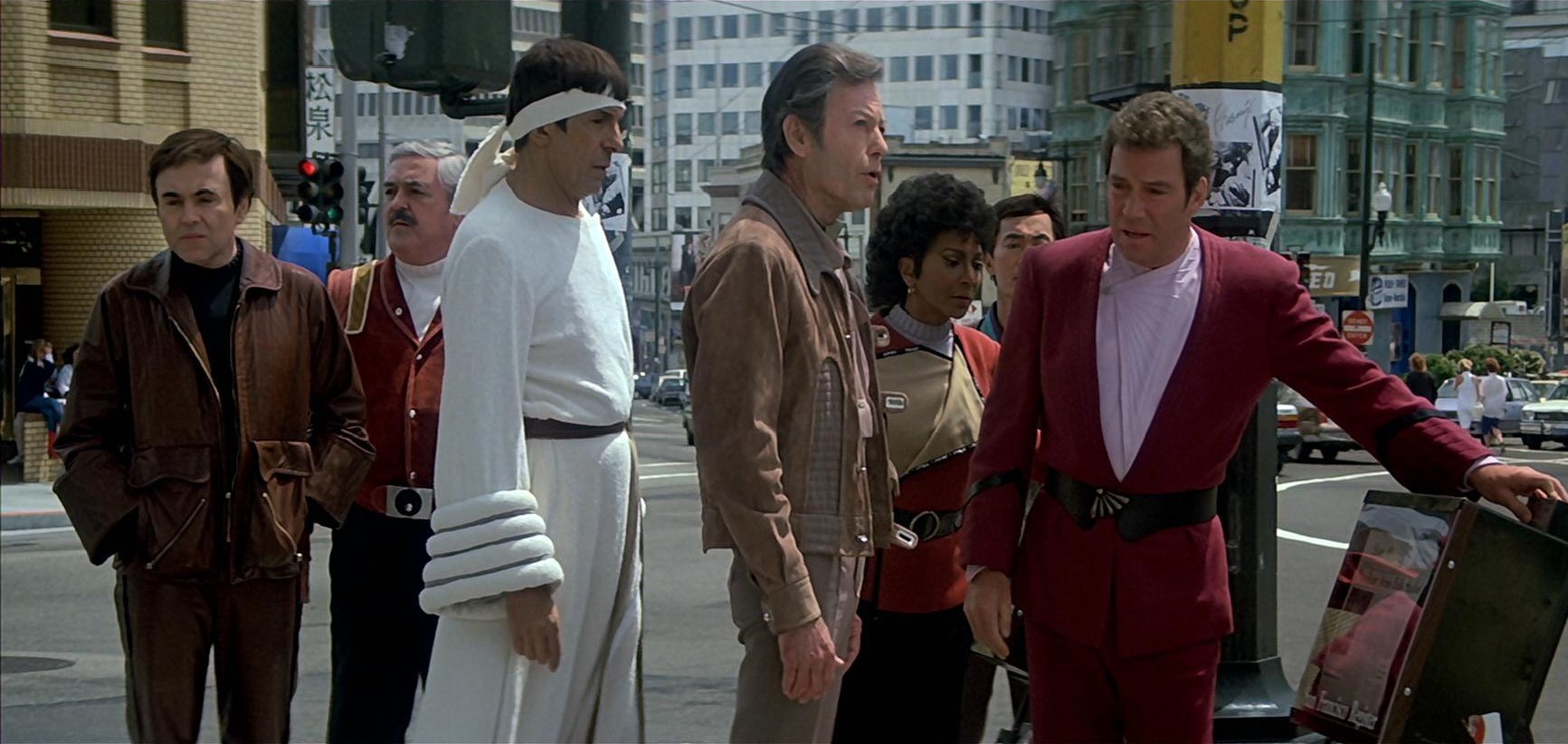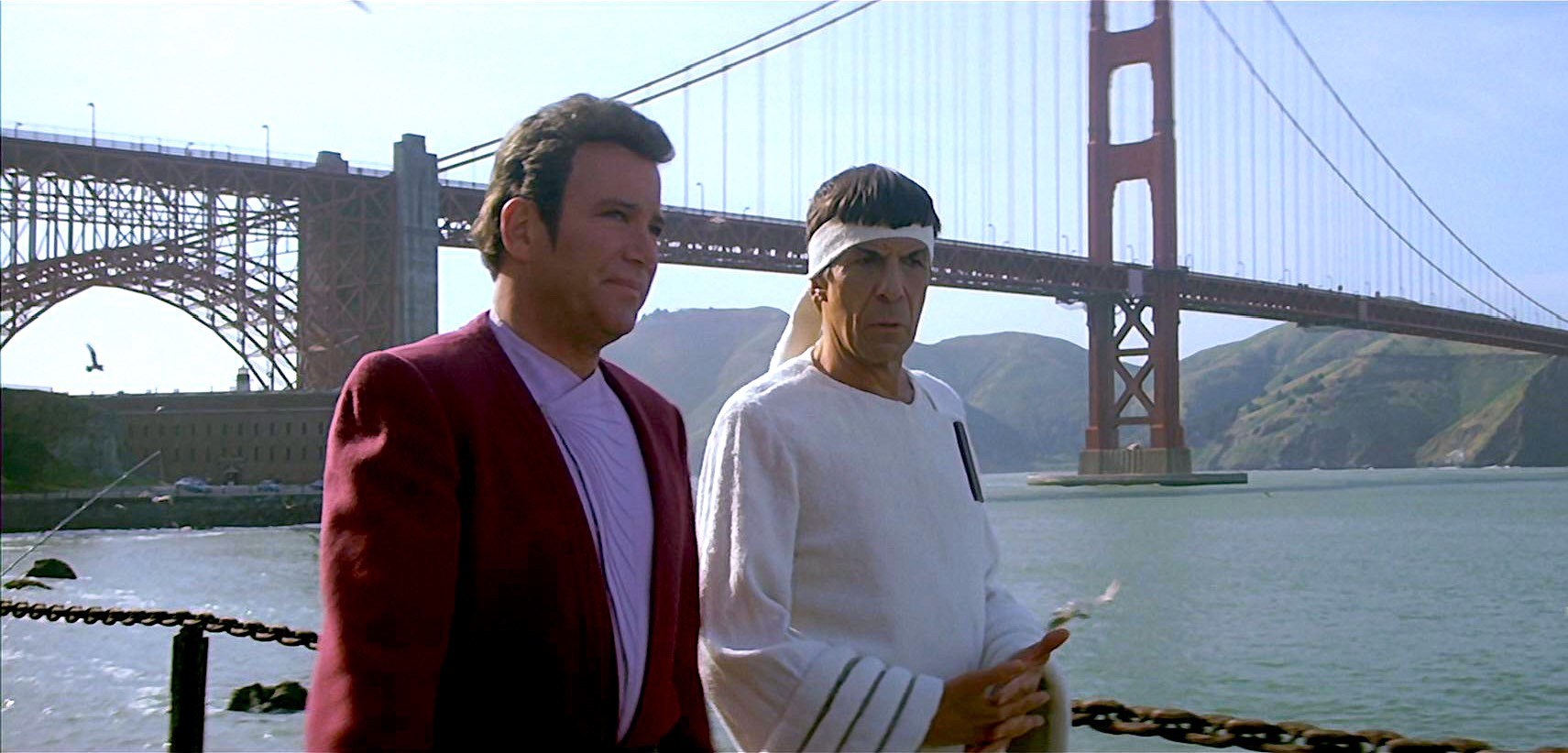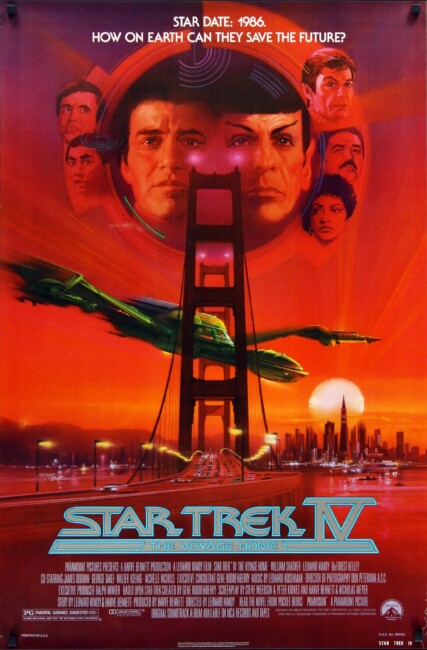aka Star Trek IV: The Voyage Home
Crew
Director – Leonard Nimoy, Screenplay – Harve Bennett, Peter Krikes, Steve Meerson & Nicholas Meyer, Story – Harve Bennett & Leonard Nimoy, Producer – Harve Bennett, Photography – Don Peterman, Music – Leonard Rosenmann, Visual Effects – Industrial Light and Magic (Supervisor – Ken Ralston), Special Effects Supervisor – Michael Lantieri, Makeup – Richard Snell, Production Design – Jack T. Collis. Production Company – Paramount
Cast
William Shatner (Admiral James T. Kirk), Leonard Nimoy (Spock), DeForest Kelley (Dr Leonard McCoy), Catherine Hicks (Dr Gillian Taylor), James Doohan (Mr Scott), Walter Koenig (Chekov), George Takei (Sulu), Nichelle Nichols (Uhura), Mark Lenard (Sarek), Jane Wyatt (Amanda), Robin Curtis (Saavik), John Schuck (Klingon Ambassador)
Plot
The Enterprise crew decide to return to Earth to face charges over their mutineering actions. They depart from Vulcan aboard the captured Klingon ship, rechristened The Bounty. Meanwhile, a vast probe vessel has been moving through Federation space, broadcasting cryptic signals and blanking out all power transmission when it receives no reply. The Enterprise crew return just as the probe reaches Earth. Spock recognises the signals being broadcast as the sounds of humpback whales, a species that is extinct in the 23rd Century. Kirk makes the decision to travel back in time to the 20th Century to obtain a whale in hope of stopping the probe’s wake of devastation. However, back in the San Francisco of 1986, the crew’ futuristic ways prove to be at odds with contemporary society.
The Voyage Home: Star Trek IV was the fourth of the films spun off from the tv series Star Trek (1966-9). Star Trek – The Motion Picture (1979) had been an over-budgeted folly that had crucially flopped with the fan audience but the series had recouped with Star Trek II: The Wrath of Khan (1982), which crafted a genteel story about the series characters coming to terms with middle-age. The film series did not hit its stride until Star Trek III: The Search for Spock (1984) where Leonard Nimoy took the directorial reins and shaped the series into a genial comic ensemble where the regular cast members would come on and each have their own piece. It was an approach pitched directly to the fans – and one that proved the creative death knell of the Star Trek film series.
The Voyage Home: Star Trek IV was Leonard Nimoy’s second directorial outing. There is something about The Voyage Home that has a conceptual laziness. It feels as though it has been put together out of a constructor set of influences. Leonard Nimoy’s more indulgently humorous and personalised take in Star Trek III: The Search for Spock had been successful – so The Voyage Home: Star Trek IV is all comedy.
The original Star Trek had visited Earth’s past three times during the run of the original show in the episodes Tomorrow is Yesterday (1967), the classic The City on the Edge of Forever (1967) and Assignment: Earth (1968). However, time travel themed films were all the rage at the time with runaway box-office successes like The Terminator (1984) and Back to the Future (1985), so The Voyage Home features up a thinly concocted time travel plot. And to show this is a serious film, it is run over with a woolly patina of ‘Save the Whales’ Greenpeace activism, although as a political message this proves no deeper than a banner for a high-school social studies project.

Mostly though, The Voyage Home: Star Trek IV is a film that has been played safe the whole way. The films, the Star Trek conventions and the fan audience have proven Shatner, Nimoy, et al’s bread and butter to an extent that they could safely make a living entirely from these alone – requesting $10,000 fees per appearance at a convention – or in spinoff merchandising (George Takei began the trend and then, following the success of William Shatner’s TekWar series of Cyberpunk novels, every single one of the original series cast members excepting DeForest Kelley had some work of fiction or a comic-book series and later an autobiography spun off under their name). In almost every case, the acting jobs that any of them have taken up outside of the Star Trek series and films could be countered on the fingers of one hand. The cast’s increasing hands-on involvement with the films began to look less like seeking new artistic directions and more and more like a group trying not to endanger their staple income. The creative conservatism that resulted was sad to see.
By the time of The Voyage Home: Star Trek IV, it was nearly two decades on from the end of the original series and any adventurous step that has been taken – the killing off of a major character (Spock), the deeming obsolete and destruction of the Enterprise, the introduction of newer, younger characters (Saavik, David Marcus, Ilia, Decker), even the promotion of Captain Kirk to an Admiral – had been introduced only to be timidly rescinded. The point at the end of this film where Kirk is presented with a new Enterprise takes the series back to exactly the same place it was at at the start of the first film; the subtitle The Voyage Home is appropriate, for the only adventure the Enterprise and crew have been on is in lazy big circle to arrive back in exactly the same place they were at when the tv series ended in 1969.
One longs for the old tv Star Trek that was out there pushing frontiers and discovering new worlds. Indeed, a year following The Voyage Home: Star Trek IV, Gene Roddenberry returned to the airwaves with Star Trek: The Next Generation (1987-94), which within a couple of years managed to usurp the popularity of Classic Star Trek with original adventures that were out there pushing new frontiers, while on the big screen all the remained of the original voyages were the intergalactic reminisces of a group of middle-aged dinosaurs playing to fan nostalgia.

Most obvious here also is the clear anti-science-fictional thrust of Leonard Nimoy’s Star Trek films. The plots of Leonard Nimoy’s Trek films seem deliberately designed to cut off and end where the loose, likable character humour does and before they get into any wider implications of their ideas. As was the case in Star Trek III: The Search for Spock where the title character was resurrected in a way that neatly avoided any discussion of the how’s, why’s or eschatological implications involved, The Voyage Home: Star Trek IV has been streamlined to take the film where it wants to go as quickly as possible with the minimum of impeding development. The business of time-travel is conducted astonishingly casually via a mere trip around the sun (although the sequence does contain a particularly beautiful abstract computer-animated sequence). Most frustratingly, the film raises the impressively menacing plot device of the alien probe at the start and then sends it away at the end without any explanation of what it is or where it comes from, granting it no more substance than as a plot device to get everybody back to the present day. For a science-fiction film, that is conceptual shabbiness.
The Voyage Home is not a film without its enjoyment. There are some amiable scenes – with Kirk trying to manage 20th Century colloquialisms, Scotty’s attempts to voice-activate a mouse and especially the scenes breaking into the hospital and McCoy’s outrage at the barbarism of 20th Century medicine. Many Star Trek fans rate The Voyage Home: Star Trek IV, along with Star Trek II: The Wrath of Khan, as the best of the Star Trek films. Eventually though it is a sense of humour that forces all the characters, especially Spock, to become deadpan comic props. Even the score plays it clearly cartoony and comic. (This was inexplicably nominated for an Academy Award, whereas Jerry Goldsmith’s much superior scores for Star Trek – The Motion Picture and Star Trek: First Contact (1996), and James Horner’s fine work for Star Trek II: The Wrath of Khan and Star Trek III: The Search for Spock were not).
The other Classic Star Trek films are: Star Trek – The Motion Picture (1979), Star Trek II: The Wrath of Khan (1982), Star Trek III: The Search for Spock (1984), Star Trek V: The Final Frontier (1989) and Star Trek VI: The Undiscovered Country (1991). Star Trek: Generations (1994), Star Trek: First Contact (1996), Star Trek: Insurrection (1998) and Star Trek: Nemesis (2002) are based on Star Trek: The Next Generation. Star Trek (2009), Star Trek: Into Darkness (2013) and Star Trek: Beyond (2016) were reboots of the classic series, which recast the classic roles with new faces. The other Star Trek tv series are Star Trek: The Next Generation (1987-94), Star Trek: Deep Space Nine (1993-9), Star Trek: Voyager (1995-2001), Enterprise (2001-5), Star Trek: Discovery (2017– ), Star Trek: Picard (2020-23), the animated Star Trek: Lower Decks (2020- ), Star Trek: Prodigy (2021- ) and Star Trek: Strange New Worlds (2022- )..
Trailer here

